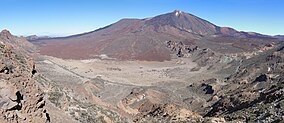| Teide National Park | |
|---|---|
 | |
| Location | Tenerife, Spain |
| Coordinates | 28°15′47″N 16°36′58″W / 28.263°N 16.616°W |
| Area | 189.9 km2 |
| Established | 1954 |
| Visitors | 4 million visits yearly |
| Type | Natural |
| Criteria | vii, viii |
| Designated | 2007 (31st session) |
| Reference no. | 1258 |
| Region | Europe and North America |

Teide National Park (Spanish: Parque nacional del Teide, pronounced [ˈpaɾke naθjoˈnal de ˈtejðe]) is a national park located in Tenerife, Canary Islands, Spain.
The national park is centered on Mount Teide, the highest mountain of Spain (3,718 meters high) in addition, the highest volcano in the Atlantic Ocean islands and the third highest volcano in the world from its base in the ocean floor (7.500 meters high). Pico Viejo, also included within the national park limits, is the second highest volcano in the Canary Islands with its 3,135 m peak. Mount Teide and Pico Viejo are the only two peaks in the Canary islands rising above the 3,000 m level.[1]
The park has an area of 18,990 hectares located in the municipality of La Orotava.[2] It was named a World Heritage Site by UNESCO on June 28, 2007.[3] Since the end of 2007, it has also been one of the 12 Treasures of Spain. On a ridge, to the east of Teide, are the telescopes of the Observatorio del Teide.
Teide is the most visited national park in Spain and −by 2015− the eighth most visited in the world,[4] with some 3 million visitors yearly.[5] In 2016, it was visited by 4,079,823 visitors and tourists reaching a historical record.[6][7]
There are morning and afternoon coach trips through the park, departing from selected areas in the south of Tenerife's tourist towns. Access to the peak requires a free permit that needs to be booked in advance.[8]
- ^ "The Geology of the Canary Islands - 1st Edition". shop.elsevier.com. Retrieved 2023-06-22.
- ^ "BOE.es - BOE-A-1999-24700 Resolución de 14 de octubre de 1999, de la Secretaria General de Medio Ambiente, por la que se publica el Acuerdo por el que se amplían los límites del Parque Nacional del Teide por incorporación de terrenos colindantes al mismo". www.boe.es. Retrieved 2022-05-15.
- ^ "Teide National Park". World Heritage List. UNESCO. Retrieved 2009-01-18.
- ^ En las entrañas del volcán|El Español
- ^ "Parque Nacional del Teide. Ascenso, Fauna, Flora..." Retrieved March 21, 2016.
- ^ El Teide bate récord de visitantes y supera los cuatro millones
- ^ El Teide bate su récord de visitantes en 2016, con más de cuatro millones
- ^ "Mount Teide Cable Car Prices and Timetable | Volcano Teide". www.volcanoteide.com. Retrieved 2018-06-20.

